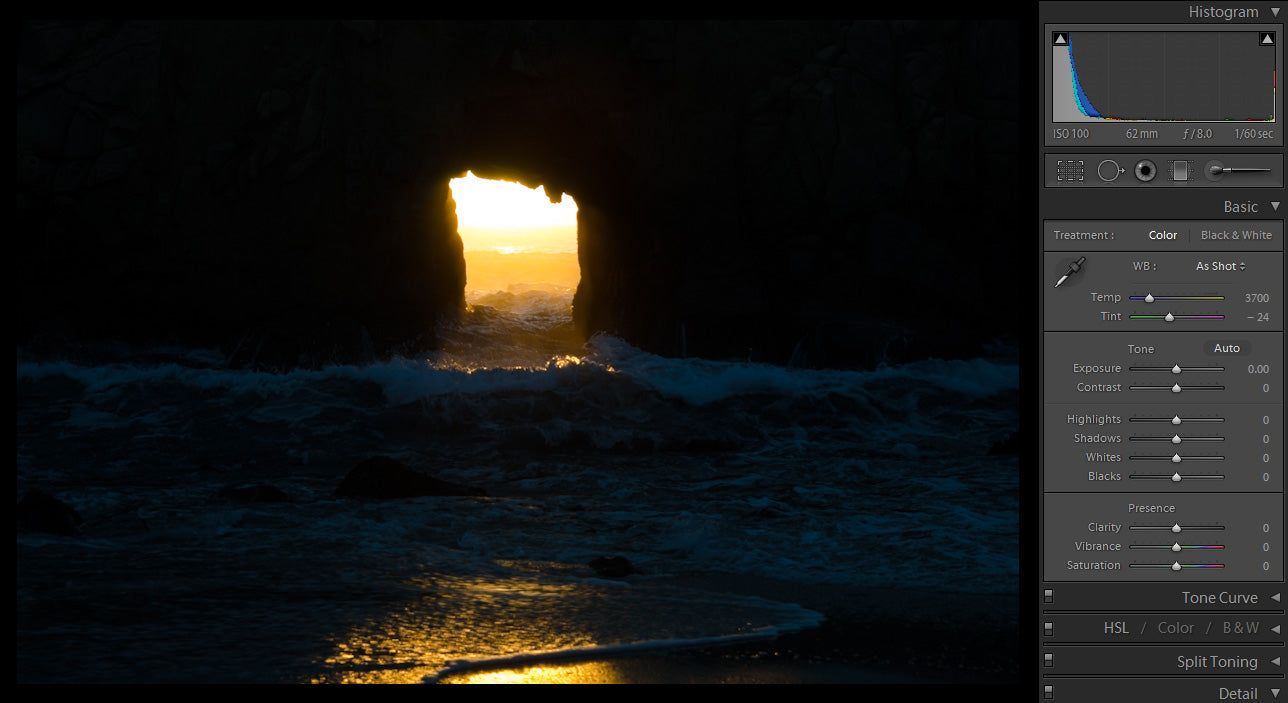Photographer Matthew Kuhns (www.matthewkuhnsphotography.com) is a California-based landscape photographer with images published in Popular Photo and PDN. Matthew has been producing landscape imagery across the United States for many years. Matthew is also a practicing aeronautical engineer. This endeavor has helped him better understand the forces of nature and its energies: the movement of wind, the play of light, and the relentlessness of geologic change.
You may have heard a lot of photographers say, shoot in RAW—not jpeg! But why are they saying that? Is it a fad? Is it to sound cool? There actually are reasons, so I will join in the tumult and say, shoot RAW!
I was looking through some old images of Pfeiffer Beach at Big Sur and found this shot that was still in an old Lightroom format. When I updated it to version 4, many of the adjustments I had made went awry, so I reverted to the original RAW settings....and was stunned. I could barely tell what the image was, and the histogram is about as bad as you can get—blown on both ends with nothing in the middle.
I was so surprised at the change that I took it as a challenge to see if I could make the image look passable again. I started with Lightroom adjustments and really took advantage of the highlight and shadow recovery features Abobe has added. I was able to recover nearly all of the shadows and a few of the highlights at the cost of introducing noise into the image. My final Lightroom adjustments before exporting to Photoshop are shown below.
 After bringing the file into Photoshop, I used luminosity layers, curves adjustments, levels adjustments, and Nik Viveza to fine tune the image (see below). I won't go into detail, but everything I did was an attempt to bring color and depth back into the image. It looks dull in Lightroom because a side effect of a dark histogram is a reduced amount of information stored in the pixels. This is due to the way color "bit" data is stored. You can fit more data on the light (right) side of the histogram, which is why another common photography phrase is "shoot to the right." Shooting to the right takes advantage of the additional color data in the digital signal, but the trade off is that if highlights get blown out they are less recoverable than shadows. With this information, I modify the way I bias my histogram depending on the conditions. If everything is very controlled, I will bias to the right; however if the image has a large dynamic range, I tend to bias towards the shadows accepting the loss of bits for more recovery leeway in post processing.
After bringing the file into Photoshop, I used luminosity layers, curves adjustments, levels adjustments, and Nik Viveza to fine tune the image (see below). I won't go into detail, but everything I did was an attempt to bring color and depth back into the image. It looks dull in Lightroom because a side effect of a dark histogram is a reduced amount of information stored in the pixels. This is due to the way color "bit" data is stored. You can fit more data on the light (right) side of the histogram, which is why another common photography phrase is "shoot to the right." Shooting to the right takes advantage of the additional color data in the digital signal, but the trade off is that if highlights get blown out they are less recoverable than shadows. With this information, I modify the way I bias my histogram depending on the conditions. If everything is very controlled, I will bias to the right; however if the image has a large dynamic range, I tend to bias towards the shadows accepting the loss of bits for more recovery leeway in post processing.
I cropped the final image as a panoramic, my original vision for the shot. I always find it impressive how far an image can be pulled back if you have a RAW file to work with; however, in this case, even with the recovered detail I am unhappy with how the water looks, so I will have to return to Big Sur again soon for another try!
Even if you decide to not shoot in RAW for every photo I hope this helps show you what is possible in case you ever need to take advantage of its power.




